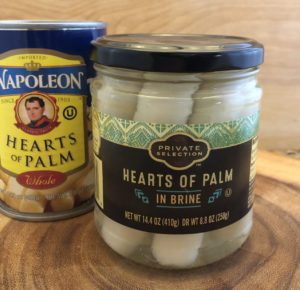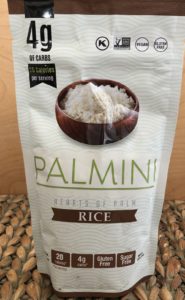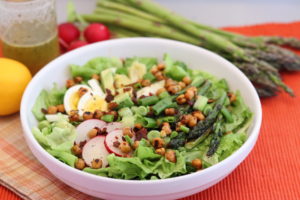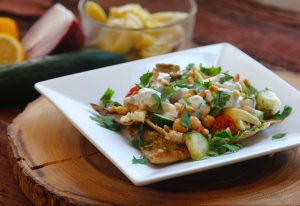Hearts of palm?
Have you heard of it?
Does it sound exotic and expensive?
This unique veggie was foreign to us until several years ago. We were at a restaurant in New York and ordered a Steak Salad that included romaine lettuce, heart of palm, tomatoes, cucumber, carrots, radishes, scallions, and feta, tossed in a garlic vinaigrette. The salad came out and looked spectacular.
However, there was this four-inch-long white tubular thing on the salad (about the size of a quarter in width), and we had no idea what it was!
We knew all the other  ingredients, and so we assumed that must be the heart of palm. Intrigued and having no idea what it was or what it would taste like (or if it was even healthy), we took a bite and were even more intrigued. We sliced it up and mixed it in with the rest of the salad…it added a delightful texture and flavor to what turned out to be a deliciously memorable meal!
ingredients, and so we assumed that must be the heart of palm. Intrigued and having no idea what it was or what it would taste like (or if it was even healthy), we took a bite and were even more intrigued. We sliced it up and mixed it in with the rest of the salad…it added a delightful texture and flavor to what turned out to be a deliciously memorable meal!
This meal inspired us to learn more about “heart of palm,” so we called on our research assistant (you know the one…Google!) to get the scoop. It turns out heart of palm is a super-nutritious veggie (and, yes, it is a REAL food!). In case you haven’t yet been introduced to hearts of palm, we hope to inspire you to give it a try and find your favorite way to enjoy it!
What are hearts of palm?
 They are a vegetable harvested from the center stalk and from the buds of certain varieties of palm trees. They are sometimes referred to as “palmitos,” especially in South and Central America. Once hearts of palm are harvested (which can be a labor-intensive process), they are cut into sections that are a few inches long. The width can range in size, typically from the size of a dime to a quarter. Fresh hearts of palm are difficult to find because they are very perishable (and also very expensive). However, most grocery stores now carry canned or jarred hearts of palm preserved in water or a brine to extend the shelf life. If you can’t find them in your local store, you can definitely find them online.
They are a vegetable harvested from the center stalk and from the buds of certain varieties of palm trees. They are sometimes referred to as “palmitos,” especially in South and Central America. Once hearts of palm are harvested (which can be a labor-intensive process), they are cut into sections that are a few inches long. The width can range in size, typically from the size of a dime to a quarter. Fresh hearts of palm are difficult to find because they are very perishable (and also very expensive). However, most grocery stores now carry canned or jarred hearts of palm preserved in water or a brine to extend the shelf life. If you can’t find them in your local store, you can definitely find them online.
The canned and jarred hearts of palm often come either whole or sliced. If you buy them whole, they are super-easy to slice yourself. They will typically last about three months unopened in the pantry, and then you can refrigerate unused portions after opening the jar or can and they will keep for at least 7-10 days.
What do they taste like?
Hearts of palm have both a slightly crunchy and a soft creamy texture and a mild, slightly sweet flavor, making them extremely versatile in a variety of dishes. Some people describe them as “delicate.” Flavor-wise, they are very comparable to artichoke hearts. Some even describe them as a unique combination of asparagus, artichoke hearts and water chestnuts.
Are they good for you?
ABSOLUTELY! Hearts of palm are packed with a variety of vitamins, minerals (like potassium, iron and zinc) and beneficial antioxidants. An entire 14 oz can has just 80 calories, while providing 4 grams of fiber, 6 grams of protein, 6.6 mg of iron (40% of the recommended daily value) and 460 mg of potassium (more than a medium-sized banana). They are also a great anti-inflammatory food, helping reduce the risk of many diseases such as heart disease, cancer, diabetes, arthritis and Alzheimer’s, among many others.
Because the canned and jarred varieties are often preserved in a brine solution, they can be a bit high in sodium. Just like beans, you can rinse them to reduce the sodium content. And, if you can find them in preserved in water instead of brine, that is even better! Also, if you are buying them in the can, it is worth checking to make sure the can is BPA-free.
How do you use them?
Because of their texture and mild flavor, they are ideal for so many recipes! Slice them and use as a salad topping, incorporate them into dips, add them to stir-fries, or make them part of a ceviche (or even make them the star of the show). They are an excellent addition to omelets and frittatas. You can also cut or shred them and use them as a meat or seafood substitute – some ideas include crab cakes, taco filling, “pulled pork,” lobster rolls, or calamari. Believe it or not, you can even roast them and grill them! Plus, they are a great substitute for artichoke hearts and can even be substituted for asparagus in some recipes.
If you are looking for some inspiration, check out these recipes:
Hearts of Palm, Jicama & Asparagus Salad
Try substituting hearts of palm for artichoke hearts in these and other recipes:
Spring Vegetable Orzo Pasta Salad
Lamb Meatballs with Mint Pesto Pasta
Grilled Veggie & Tortellini Salad
Swap for asparagus (or keep the asparagus and add hearts of palm) to recipes like:
Roasted Strawberry and Asparagus Salad
Pasta with Mint, Lemon & Spring Peas
What about a pasta or rice replacer?
 In the last few years, a few companies have started selling pasta and rice made from hearts of palm. The one that is most readily available is from a company called Palmini, which was on a Shark Tank episode in 2018.
In the last few years, a few companies have started selling pasta and rice made from hearts of palm. The one that is most readily available is from a company called Palmini, which was on a Shark Tank episode in 2018.
We will be honest…we were skeptical, could hearts of palm really compare to pasta or rice? First, we tried the hearts of palm rice in our Kedgeree Rice Bowl and were pleasantly surprised! The texture was really good and it made for a delicious breakfast.
Now we wondered, could the pasta be just as good?
We went for it and sauteed some mushrooms, added some arugula and leftover roasted veggies, and then stirred in some of the angel hair hearts of palm pasta and sauteed it for just a few more minutes. The result? It was really fantastic! The pasta had a slight crunch, and it seemed like a combination between al dente pasta and spaghetti squash. It can be a little pricy, but both the rice and pasta are definitely worth a try if it fits in your budget or if you can find it on sale. They also sell linguine and lasagna noodles, although we haven’t tried those yet.
 We are not in the camp of “grain carbs are bad and should be avoided,” but let’s face it…Americans tend to have too high of a grains to veggie ratio on their plates. This is a great way to increase your veggie to grain ratio! With an innovative way to increase your VEGGIE consumption like this, we say go for it!
We are not in the camp of “grain carbs are bad and should be avoided,” but let’s face it…Americans tend to have too high of a grains to veggie ratio on their plates. This is a great way to increase your veggie to grain ratio! With an innovative way to increase your VEGGIE consumption like this, we say go for it!
Give it a try!
We encourage you to pick up a can or a jar of hearts of palm (or maybe some rice or pasta)…
and please let us know what you think!





I thought Hearts of Palm was a tropical item and therefore high in cholesterol !!!!